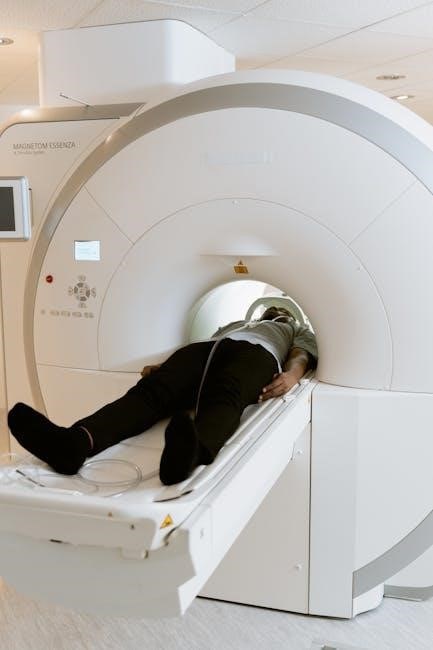The ABLLS Assessment is a comprehensive tool for evaluating language and learning skills in individuals with developmental delays. Widely used in educational and clinical settings, it provides a detailed framework for assessing foundational communication abilities and tracking progress over time. The ABLLS-R Protocol, available as a downloadable PDF, serves as a curriculum guide and skills-tracking system, aiding professionals in creating personalized intervention strategies. Its structured approach ensures accurate assessment and supports effective language development programs.
What is the ABLLS Assessment?
The ABLLS Assessment, or Assessment of Basic Language and Learning Skills, is a comprehensive tool used to evaluate and track language development in individuals with developmental delays or disabilities. It serves as both an assessment instrument and a curriculum guide, helping professionals identify foundational skills and create targeted intervention strategies. The ABLLS-R (Revised) version is widely used in educational and clinical settings to support language development and learning. Available as a downloadable PDF, it provides a structured framework for accurate assessment and progress tracking.
Importance of the ABLLS Assessment in Educational and Clinical Settings
The ABLLS Assessment is crucial in educational and clinical settings as it provides a standardized method for evaluating and tracking language development in individuals with developmental delays. Its structured framework allows professionals to identify skill gaps and monitor progress effectively. By offering a comprehensive curriculum guide, it aids in creating personalized intervention plans. This tool is invaluable for speech therapists, educators, and clinicians, ensuring consistent and evidence-based support for learners with diverse needs, fostering effective communication and learning outcomes.

Purpose and Benefits of the ABLLS Assessment
The ABLLS Assessment helps identify skill gaps, provides a curriculum guide, and supports tailored interventions. It benefits professionals and learners by improving communication and learning outcomes effectively.
Understanding the Goal of the ABLLS-R
The ABLLS-R aims to assess language and related skills in individuals, particularly those with autism or developmental delays. Its primary goal is to identify skill gaps and track progress, enabling professionals to create targeted intervention plans. By evaluating receptive, expressive, social, and academic skills, the ABLLS-R provides a comprehensive profile of an individual’s abilities. This assessment tool aligns with ABA practices, offering a structured approach to language development and learning. Available as a PDF, it ensures accessibility for educators and clinicians.
How the ABLLS Assessment Supports Language Development
The ABLLS assessment is a valuable tool for supporting language development by identifying specific skill deficits and strengths. It provides a detailed framework for evaluating receptive and expressive language, allowing professionals to design targeted interventions. By breaking down language into measurable components, the ABLLS-R helps track progress over time. This structured approach ensures that individuals receive tailored support, fostering meaningful communication and social interaction skills. Regular use of the ABLLS assessment PDF enhances customize learning strategies.

Development and History of the ABLLS Assessment
The ABLLS Assessment was developed by Partington and Mueller in 2002, based on behavioral principles. It has evolved into the ABLLS-R, enhancing its effectiveness in language assessment.
Evolution of the ABLLS Assessment Over Time
The ABLLS Assessment has undergone significant updates since its introduction. The revised ABLLS-R incorporates enhanced assessment protocols and expanded skill categories. Originally focusing on foundational language skills, it now includes advanced competencies. Updates ensure alignment with modern educational standards and ABA practices. The 2020 update introduced a streamlined protocol and improved scoring guidelines. These changes reflect advancements in understanding language development and the need for comprehensive assessment tools. The ABLLS-R continues to evolve, offering robust resources for educators and clinicians.
Key Contributors to the ABLLS-R Development
The ABLLS-R was developed by Dr. James Partington, a renowned expert in language assessment and ABA. Dr. Partington’s work laid the foundation for the tool, focusing on practical application in educational settings. Collaborators like Dr. Mark L. Sundberg also contributed, bringing expertise in verbal behavior and language development. Their collective efforts ensured the ABLLS-R aligns with evidence-based practices, providing a comprehensive framework for assessing and teaching language skills to individuals with diverse learning needs.

Components of the ABLLS Assessment
The ABLLS assessment includes evaluation tools, scoring guidelines, and structured frameworks to assess language and learning skills, facilitating personalized intervention and progress tracking effectively.
The ABLLS-R Protocol and Its Structure
The ABLLS-R Protocol is a comprehensive assessment tool designed to evaluate language, social, and self-help skills in individuals with developmental disabilities. It is divided into three main sections: language, social, and self-help skills, each containing specific items to assess. The protocol uses a criterion-referenced scoring system, allowing for accurate tracking of progress over time. Detailed scoring guidelines ensure consistency, while data collection forms, such as the Imitation Tracking Sheet, support thorough assessment. This structured approach provides a clear framework for identifying skill levels and developing targeted intervention strategies, making it an essential resource for professionals and parents alike.
Scoring Guidelines and Interpretation
The ABLLS-R scoring guidelines provide a clear framework for evaluating responses, with scores ranging from 0 to 3. A score of 0 indicates no mastery, 1 reflects emerging skills, 2 indicates independent mastery, and 3 signifies advanced proficiency. Interpretation involves analyzing scores to identify skill strengths, gaps, and progress over time. This data informs targeted interventions and tracks developmental improvements, ensuring accurate and meaningful assessment outcomes for individuals with diverse learning needs.

ABLLS Imitation Tracking Sheet Templates
ABLLS imitation tracking sheets are tools to monitor a learner’s ability to imitate actions, sounds, and words, aiding in assessing and developing language skills effectively.
Role of Imitation in Language Development
Imitation plays a pivotal role in language development, particularly within the ABLLS assessment framework. It serves as a foundational skill for learning, enabling individuals to replicate sounds, words, and actions observed in their environment. Verbal imitation, such as repeating words or phrases, is crucial for vocabulary acquisition and understanding linguistic structures. Similarly, motor imitation, involving gestures and movements, contributes to non-verbal communication skills. Both types of imitation are essential for social interaction and are often assessed to evaluate an individual’s ability to learn and communicate effectively. The ABLLS tracking sheets help document and monitor these imitative skills, providing insights into an individual’s developmental progress and guiding targeted interventions to enhance their language abilities.
How to Use Imitation Tracking Sheets Effectively
Effective use of imitation tracking sheets involves systematic observation and consistent recording of imitative behaviors. Set clear goals for specific imitations, such as words or actions, and provide immediate feedback to reinforce learning. Track progress over time to adjust teaching strategies and ensure consistent use during regular sessions. Proper training for administrators is crucial for accurate and reliable data collection. Integrating these sheets with other assessments enhances comprehensive progress monitoring and informs coordinated interventions across educational and clinical settings. Reviewing and updating goals periodically ensures the tracking sheets remain relevant and effective in guiding language development. Tailoring interventions based on the data helps meet the individual’s evolving needs.
Applications of the ABLLS Assessment
The ABLLS Assessment is widely applied in educational and clinical settings to identify skill levels, track progress, and guide language-based interventions for learners with diverse needs.
Using ABLLS in Educational Settings
The ABLLS Assessment is a valuable tool in educational settings, helping educators identify skill gaps, create personalized learning plans, and monitor progress for students with diverse learning needs. It aligns with IEP goals, enabling data-driven instruction. The ABLLS Assessment PDF provides a structured framework for teachers to assess and support language development, ensuring consistent and measurable outcomes. Its application fosters inclusion and tailored interventions, promoting academic and social growth for all learners.
Clinical Applications of the ABLLS Assessment
The ABLLS Assessment is widely used in clinical settings to evaluate and address language delays in individuals with autism or developmental disabilities. Clinicians rely on the ABLLS Assessment PDF to identify skill deficits, track progress, and guide intervention strategies. It supports the development of individualized treatment plans, enabling targeted therapies to improve communication skills. The assessment’s structured approach ensures reliable data collection, aiding clinicians in making informed decisions and monitoring long-term outcomes effectively.

Integration with ABA Practices
The ABLLS Assessment integrates seamlessly with ABA practices by providing data-driven insights to inform behavioral goals and strategies, enhancing personalized intervention plans and skill-tracking processes effectively.
Link Between ABLLS and Applied Behavior Analysis (ABA)
The ABLLS Assessment is a foundational tool in ABA practices, providing comprehensive data on language and learning skills. This data directly informs the creation of personalized ABA programs, ensuring interventions are tailored to individual needs. By identifying skill gaps and strengths, ABA professionals can develop targeted strategies to enhance learning outcomes. The integration of ABLLS with ABA supports a data-driven approach, fostering effective and measurable progress in skill development and behavior modification, aligning with ABA’s focus on evidence-based practices.
How ABLLS Inform ABA Intervention Strategies
The ABLLS Assessment provides detailed data on an individual’s language and learning skills, which directly shapes ABA intervention strategies. By identifying specific skill deficits and strengths, ABA professionals can prioritize goals, develop targeted teaching methods, and allocate resources effectively. The assessment’s findings guide the creation of personalized programs, ensuring interventions address the most critical areas first. This alignment with ABA principles ensures that strategies are evidence-based, measurable, and tailored to the learner’s unique needs, fostering meaningful progress and skill acquisition.

Digital Tools and Resources for ABLLS
Digital tools like CentralReach streamline ABLLS-R and AFLS assessments, offering PDF downloads for easy access and efficient administration, enhancing the assessment experience for professionals.
CentralReach ABLLS-R AFLS CR Assessments
CentralReach provides comprehensive digital solutions for ABLLS-R and AFLS assessments, offering streamlined administration, scoring, and progress tracking. Professionals can access ABLLS assessment PDFs seamlessly, ensuring efficient data management. The platform integrates with ABA practices, enabling precise tracking of learner progress and skill mastery. CentralReach enhances organization, reduces paperwork, and supports data-driven decision-making, making it an essential tool for educators and clinicians working with individuals with autism or developmental delays.
ABLLS-R Protocol PDF Downloads and Accessibility
The ABLLS-R Protocol is widely available in PDF format, offering convenient access for professionals. Official publishers and authorized platforms provide downloadable versions, ensuring easy access for assessment administration. The PDFs are often searchable and bookmarked for efficient navigation. Accessibility features include compatibility with screen readers and adjustable font sizes. Additionally, many resources offer digital versions compatible with various devices, making the ABLLS-R Protocol adaptable for diverse user needs and enhancing its utility in clinical and educational settings.
ABLLS User Manual and Guide
The ABLLS User Manual provides comprehensive guidance for administering and interpreting the assessment, ensuring effective implementation in educational and clinical settings.
Navigating the ABLLS Manual for Effective Use
The ABLLS manual is a crucial resource for professionals, providing detailed instructions for administering and interpreting the assessment. It includes sections on test administration, scoring guidelines, and understanding results. The manual also offers practical examples and troubleshooting tips to ensure accurate implementation. By following the manual, users can maximize the effectiveness of the ABLLS assessment, tailoring it to individual needs and improving language development outcomes. Regularly referencing the manual ensures consistency and reliability in assessment practices.
Mastering ABLLS Functions and Capabilities
The ABLLS assessment offers robust tools for evaluating language and behavioral skills, with features like skill tracking, progress monitoring, and customizable reports. The ABLLS-R protocol includes over 900 skills across 25 categories, allowing comprehensive assessment. Digital versions, such as the ABLLS assessment PDF, enhance accessibility and ease of use. By leveraging these functions, professionals can streamline assessment processes, identify learning gaps, and develop targeted interventions. This ensures effective support for individuals with diverse learning needs, aligning with ABA therapy goals and educational strategies.

Best Practices for Administering the ABLLS Assessment
Ensure a distraction-free environment, use standardized materials, and maintain accurate scoring. Stay updated on guidelines and leverage digital tools like ABLLS assessment PDFs for accessibility and efficiency.
Preparing for the ABLLS Assessment
Thoroughly review the ABLLS-R manual to understand assessment objectives and procedures. Organize required materials, including the ABLLS-R protocol, data sheets, and scoring guidelines. Familiarize yourself with the ABLLS assessment PDF format for easy reference. Conduct practice sessions to ensure proficiency in administration techniques. Ensure all tools are updated and accessible, leveraging digital platforms like CentralReach for streamlined access. Prepare a quiet, distraction-free environment to facilitate accurate and effective assessment administration.
Ensuring Accuracy in Scoring and Interpretation
Accurate scoring and interpretation are critical for meaningful ABLLS results. Ensure thorough training in ABLLS-R administration and scoring guidelines. Use the ABLLS assessment PDF as a reference for standardized procedures. Double-check scores for consistency and completeness. Utilize inter-rater reliability measures to verify accuracy. Regularly review the ABLLS-R manual and updates to stay informed. Consider digital tools, like CentralReach, for efficient and precise scoring. Accurate interpretation ensures effective intervention planning and progress tracking for individuals with autism or language delays.

Limitations and Considerations
The ABLLS assessment may have limitations, such as restricted applicability to autism-specific needs and time-consuming administration. Cultural biases and administrator expertise also impact reliability and accuracy.
Potential Limitations of the ABLLS Assessment
The ABLLS assessment may present limitations, such as requiring significant time and expertise for administration. It may not fully capture diverse cultural or linguistic backgrounds, potentially leading to biases. Additionally, its focus on autism-specific skills might limit its applicability to other developmental disorders. Reliability can also depend on the administrator’s training and consistency in scoring. These factors underscore the need for careful consideration and complementary assessments to ensure comprehensive evaluation.
Addressing Challenges in ABLLS Administration
To overcome challenges, administrators should receive comprehensive training and use detailed scoring guides to ensure consistency. Regular updates to the assessment, such as incorporating cultural sensitivity, can enhance relevance. Leveraging digital tools, like the ABLLS-R PDF, improves accessibility and reduces administrative burden. Additionally, pairing the ABLLS with other assessments can provide a more holistic view of a learner’s skills, addressing potential gaps and ensuring well-rounded support for diverse needs.

Future Directions and Updates
Future updates may include enhanced digital integration, expanded cultural adaptability, and more interactive features to improve accessibility and user experience for diverse learners and professionals globally.
Anticipated Developments in ABLLS Assessment
Anticipated developments include integrating advanced technology, such as AI-driven scoring systems and real-time data tracking, to enhance efficiency and accuracy. Updates may also focus on expanding the assessment’s scope to cover a broader range of developmental domains and incorporating diverse cultural and linguistic considerations. Additionally, there is a potential for more interactive digital tools to support remote administration and streamline the reporting process, making the ABLLS more accessible and user-friendly for professionals worldwide.
Staying Updated with ABLLS Resources and Tools
Stay updated with the latest ABLLS resources and tools by regularly visiting the official website and subscribing to newsletters. CentralReach and Autism Partnership often provide updated PDF guides and training materials. Professionals can access webinars, workshops, and forums to learn about new features and best practices. Additionally, joining professional networks ensures access to shared resources and updates, helping you stay current with advancements in ABLLS assessment and implementation.
The ABLLS assessment is a valuable tool for guiding instruction and measuring progress. Its comprehensive approach supports effective learning outcomes, making it essential for professionals in education and clinical settings.
Summarizing the Value of the ABLLS Assessment
The ABLLS assessment is a widely recognized tool for evaluating language and learning skills, particularly in individuals with autism. Its structured approach helps identify strengths and deficits, guiding personalized intervention plans. By providing a clear framework for tracking progress, the ABLLS supports educators and clinicians in making data-driven decisions. Its accessibility as a PDF enhances convenience, ensuring widespread use. This evidence-based assessment remains a fundamental resource for fostering effective learning and communication strategies in diverse settings.
Encouraging Continued Use and Exploration
The ABLLS assessment remains a vital tool for understanding and addressing language and learning needs. Encouraging its continued use ensures professionals can leverage its structured framework to support individuals effectively. Exploring new strategies and integrating the ABLLS with modern technologies can enhance its utility. By staying updated and sharing insights, professionals foster a collaborative environment, driving innovation and improving outcomes for learners across various settings.
